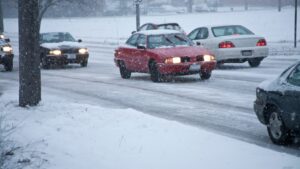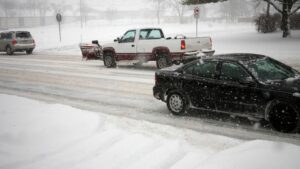Winter’s icy grip can turn roads into a slippery nightmare, making even the most routine journeys fraught with danger. But don’t let the snow put a freeze on your plans. With a little knowledge and preparation, you can navigate these frosty conditions with confidence.
Tips for Driving in the Snow
Snowy conditions increase the risk factor on roads. Grasping these risks helps in better preparation and safer travel.
The Impact of Snow on Visibility and Traction
 Snowfall, particularly during a snowstorm, dramatically reduces visibility, making it difficult to discern road markings, other vehicles, or potential hazards. With visibility cut down to as little as a few feet in front, drivers must rely heavily on their intuition and familiarity with the road.
Snowfall, particularly during a snowstorm, dramatically reduces visibility, making it difficult to discern road markings, other vehicles, or potential hazards. With visibility cut down to as little as a few feet in front, drivers must rely heavily on their intuition and familiarity with the road.
Similarly, snow’s effect on traction is namely a considerable reduction. As it blankets the road, snow creates a slippery surface, often leading to skidding or automobile control loss. Even four-wheel drive vehicles experience a decreased grip on snow-covered roads, emphasizing the amplified risks involved in snowy conditions.
Common Mistakes to Avoid
Avoiding common misjudgments can dramatically elevate safety levels during snowy conditions. One widespread mistake is rapid acceleration, as it’s likely to result in vehicle skidding. Similarly, hard braking often leads to losing control; preempting stops and braking gently helps avoid skid situations.
Drivers also frequently underestimate the stopping distance required on snow-laden roads. It’s crucial to remember that a vehicle needs approximately ten times the normal stopping distance on icy, slippery surfaces.
Lastly, driving with low visibility—without proper lighting or with a snowy windshield—poses significant danger. Always keeping lights on, using fog lights if available, and clearing off any snow from the windshield and windows before starting the journey proves absolutely necessary for one’s safety.
Essential Preparations Before Driving in Snow
Embarking on a snowy journey necessitates comprehensive preparations. Let’s explore the key measures for your vehicle’s readiness and ponder on winter tires and chains.
Checking Your Vehicle’s Winter Readiness
 A car’s response to snowy conditions isn’t a matter of chance. Regular checks and adoptions to ensure winter readiness can be pivotal. For instance, maintaining optimal levels of antifreeze prevents engine freezing. Keeping the gas tank at least half full mitigates the risk of fuel line freeze-ups.
A car’s response to snowy conditions isn’t a matter of chance. Regular checks and adoptions to ensure winter readiness can be pivotal. For instance, maintaining optimal levels of antifreeze prevents engine freezing. Keeping the gas tank at least half full mitigates the risk of fuel line freeze-ups.
Additionally, batteries respond with reduced efficiency in cold weather; thus, testing their strength prior to the season sets a constructional precedent. Furthermore, wipers, heating and defrosting systems hold a notable place in preparing cars for snow, as they control visibility. Neglecting these can lead to compromised safety. Now, let’s move onto tires and chains.
If you realize that you are lacking winter gears or your car’s condition isn’t optimal, consider the option of car shipping to avoid the risks associated with driving in snowy conditions. Car ship services can transport your vehicle safely to your destination, ensuring it remains in good condition without the need for immediate winter readiness adjustments. This can be a practical solution if your vehicle isn’t equipped for harsh winter weather or if you prefer to avoid the challenges of driving in snow.
The Importance of Winter Tires and Chains
Snowy landscapes demand a firm grip on the ground – that’s where the significance of winter tires arises. Compared to standard tires, winter tires deliver superior performance under icy conditions. Their specially designed tread patterns and rubber compounds forge a sturdy grip, even on slippery terrains. They’ve demonstrated stopping distances on ice to be up to 40% shorter than summer tires.
Chains work complementary to the winter tires, providing an unprecedented level of traction. They bolster the vehicle’s grip, especially in severe conditions. Nevertheless, chains can be detrimental if used on clear roads or at high speeds. Hence, use these only in conditions warranting extra traction, achieving safe winter driving.
Mastering snowy drives is about initiating informed decisions, like these preparations, and steering clear of reckless errors. Embrace the snow, but with preparation and caution.
Core Driving Tips for Managing Snowy Roads
 Navigating the winter roads doesn’t have to be a daunting task. With the right knowledge and preparedness, it’s possible to overcome the challenges that snowy conditions present. Ensuring vehicle readiness is paramount – it’s all about maintaining antifreeze levels, keeping the gas tank half-full, and ensuring the battery is strong.
Navigating the winter roads doesn’t have to be a daunting task. With the right knowledge and preparedness, it’s possible to overcome the challenges that snowy conditions present. Ensuring vehicle readiness is paramount – it’s all about maintaining antifreeze levels, keeping the gas tank half-full, and ensuring the battery is strong.
The added security of winter tires and chains can’t be overlooked. They’re the heroes of slippery terrains, providing the traction needed in severe conditions. But remember, even with the best preparations, it’s the driver’s decisions that ultimately dictate safety. So, avoid reckless errors and make informed choices. With these tips, you’re well on your way to mastering winter driving. Stay safe and enjoy the ride.



